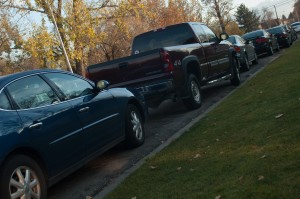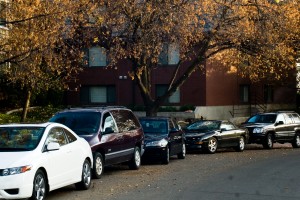
Provo resident Shannon Jenks was walking her dog around her neighborhood in southwest Provo one day when she noticed a fire truck struggling to exit a cul-de-sac full of cars. The ambulance could turn around, but the fire truck had to slowly inch into a 180-degree turn just to exit without crashing.
Julie Rash, her neighbor and the Provo City School District Board of Education president, has also been frustrated with similar overcrowding problems caused by zoning issues. Rash often struggles to find a parking spot at home between residents of over-occupied homes whose cars congest the street.
So Jenks and Rash invited city representative Dave Sewell to walk with them through their Sunset neighborhood to see the issues firsthand. That simple action paid off: Sewell walked the neighborhood with them in July and again in October to make their specific questions clear to the people who had the power to fix them.
The need for attention
Rash has been frustrated that her representatives, who don’t live near her, can’t understand the residents’ daily frustrations. She has nothing against the representatives, but she said it’s hard to understand residents’ struggles if the representatives don’t live near them. They don’t have to wait at the railroad tracks for long periods of time just to get home, she said.
Jenks said her point in contacting Sewell was to say, “Hey, we have concerns over here and we’d like some help with the issues.”
And fortunately for her and Rash, Sewell “wanted to see firsthand what was going on,” he said.
The October walkthrough included other city officials who discussed zoning issues such as Rash’s and Jenks’ experiences, but also unkempt yards, rental license violations and home businesses run without proper permits. They talked with other neighbors and met at Jenks’ home afterward.
Because Provo serves two large college communities, the high demand of student housing leads to many homeowners illegally renting out their homes to multiple single or married students, which is against the regulations of properties zoned as single family housing. This can cause issues of overcrowding, excess trash and possessions, and unkempt yards, as students are not as fully invested in the longterm welfare of the neighborhood as permanent residents.
Jenks and Rash have noticed one cul-de-sac has had up to 17 cars in it at a time. A group of five single men lives in one house and has six dogs when zoning laws allow only two dogs. Jenks said these issues are improving as they communicate more with the city and the residents, but the job is a constant one.
Sewell compared keeping on top of zoning issues in neighborhoods to maintaining roads. “If you do the maintenance of a road according to the right schedule and keeping it in good shape, it’s actually a lot less costly than if you sort of let it go until it gets to be a really big problem, and then you have to go in and do a major overhaul to the road,” he said. “It’s kind of like that with neighborhoods, too.”
While some issues may seem to affect only one area, Sewell said “if we’re not vigilant and careful in our zoning enforcement, we can have a problem spread and affect the whole neighborhood.”
Residents like Rash and Jenks fear that although they have a good neighborhood, people “who care about the neighborhood” will leave when people who “don’t care about the neighborhood” come in and contribute to zoning issues. Eventually a negative reputation develops, Rash said.
Representatives see that citywide. “The concern is if zoning isn’t enforced uniformly, then certain areas start to get a reputation of, ‘Oh, well they don’t really care what you do here.’ So then the neighborhood can start to deteriorate,” Sewell said.
He said the walkthrough was successful because it helped him and zoning officials know what to focus their work on. “They would like to prioritize their time and work on the issues that were having the most negative impact on the residents,” Sewell said.

Zoning and even crime issues are not isolated to the Sunset neighborhood. Cars commonly line and crowd streets in college towns. CrimeReports.com shows, for example, that theft especially affects the BYU area more than other areas.
Rash and Jenks noted that the Sunset neighborhood is relatively safe, but it touches one of the least safe neighborhoods in Provo, according to NeighborhoodScout.com. They want to avoid the “deterioration” principle with crimes, as well.
“There are good people over there, too, but I know there are issues over there, too,” Jenks said. She has reached out to the city ombudsman and police officers to help keep their neighborhood clean and crime-free. “We would like to keep it a safe neighborhood,” Jenks said.
The importance of individual involvement
Provo’s council executive director and two city council members, including Sewell, attended the October neighborhood walkthrough. The manager of the zoning department took notes of which issues in which houses to follow up on. But Rash and Jenks were the only residents who participated.
The walkthrough was at 5:15 p.m., when most people are finishing at work, but Rash and Jenks wished more neighbors had participated to show the concerns they know they have. “It’s not just me and Shannon,” Rash said.
Sewell said being involved in things such as walkthroughs will help other neighborhoods that don’t get a lot of attention. He said some residents can feel they are “a little bit neglected” — that if they tried to call in to report problems, the city wouldn’t listen to their complaints. But he encouraged residents to keep trying.
“One of the benefits (of the walk) was telling them we really do want to treat every area equally, and the zoning department will pay attention if you call,” Sewell said. Getting involved “can make a big difference, too,” he said.
Every notification or interaction helps city workers, Sewell said. They use callers’ reports of violations and crimes to prioritize tasks demanding their attention.
Jenks said she wanted city officials to “focus on the great residents they have here.” Participating in events such as the neighborhood walk could help regular citizens, and even non-voters, become more involved because they see that the city is listening, she said.
Sewell is personally trying to connect with residents and students by learning and participating in social media. He’s seen the effects it has in building a community, as it has for Mayor John Curtis. But he encouraged resident involvement, as well.
Jenks, for example, is considering becoming her neighborhood’s vice chair. “So many people don’t participate, so we get left behind,” she said. “If we can do it here, we can do it in other neighborhoods throughout west Provo.”




